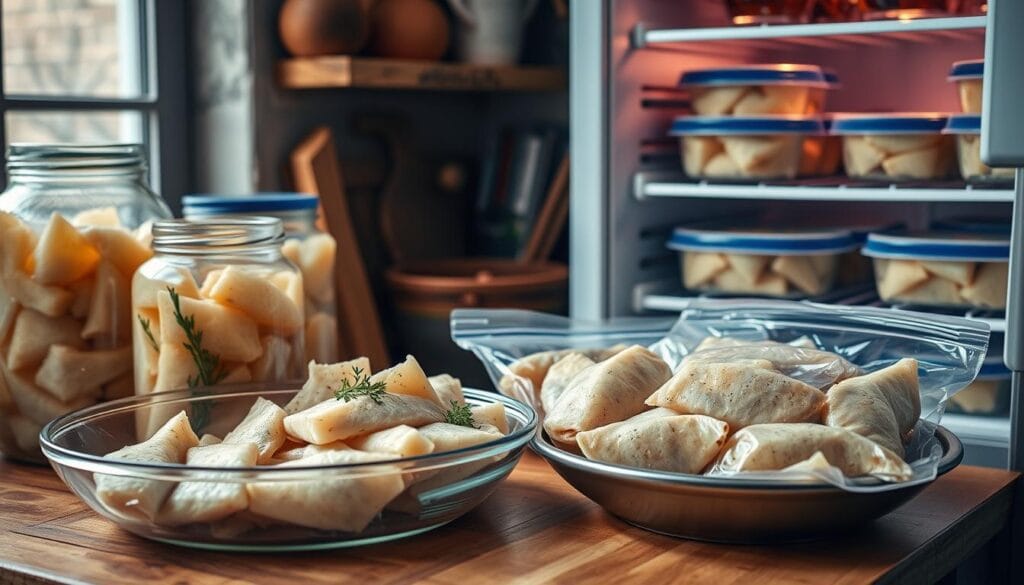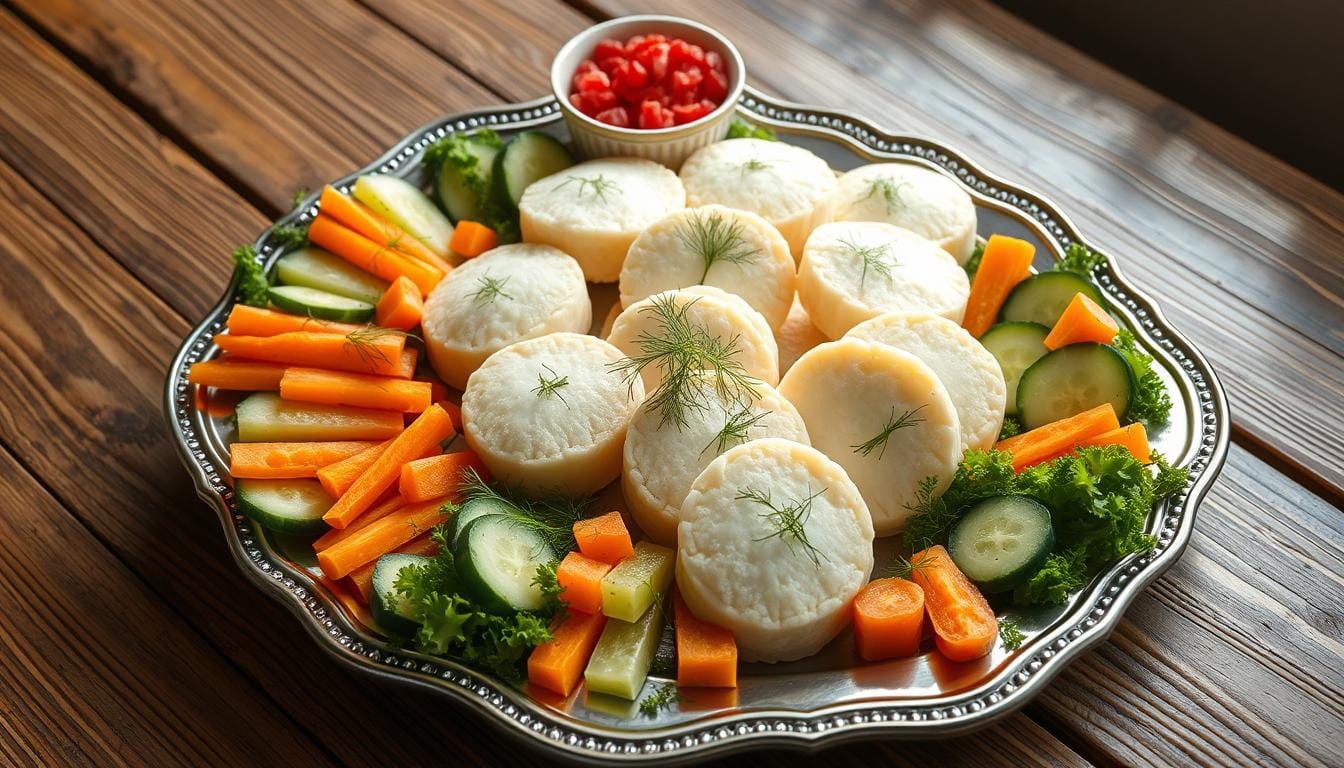Authentic Jewish Gefilte Fish: A Delicious Tradition
Growing up in a Jewish household, I remember the excitement of Shabbat dinners. My grandmother would prepare gefilte fish, a tradition that connects us. It’s more than food; it shows Jewish cultural strength and creativity.
So, what is gefilte fish? It’s ground fish made into tender, seasoned balls or patties. This dish started in medieval Europe as a way to stretch food and feed families.
It’s made from fish like whitefish, carp, or pike. Gefilte fish shows how Jewish cooks adapted, using ground fish with breadcrumbs, veggies, and eggs. This made a dish that’s a big part of Ashkenazi Jewish cuisine.
Table of Contents
Understanding the Heritage of Gefilte Fish
Gefilte fish is more than a dish; it’s a journey through Jewish history. It started as “gefuelten hechden,” or “stuffed pike.” This recipe shows how Jewish culture migrated, adapted, and stayed true to its roots.
The story of gefilte fish begins in medieval Europe. Jewish people created it to solve food challenges. They deboned fish, mixed it with spices, and made it into fish balls or patties.
Medieval Culinary Roots
The first gefilte fish recipe was in a German cookbook about 700 years ago. It was a hit during Lent, showing its appeal across cultures.
Cultural Diversity in Preparation
- German Jews liked pike fish
- Polish Jews chose carp or whitefish
- Lithuanian Jews made it spicy
- Russian Jews added beets
Symbolic Significance
Gefilte fish is more than food; it’s a symbol of Jewish strength and unity. It’s traditionally eaten on Friday nights. It connects us to our ancestors and shared traditions.
“Gefilte fish is not just food; it’s a story on a plate.”
As Jewish people moved around the world, their gefilte fish recipes changed. They used local ingredients and followed regional tastes. Each version shares a story of survival and adaptation.
Essential Ingredients for Traditional Gefilte Fish
To make a true gefilte fish, you need the right ingredients. These ingredients bring out the dish’s deep, traditional flavors. The key is to pick the best fish and seasonings.
Primary Fish Selections
Choosing the right fish is the first step. Traditional gefilte fish recipes use a mix of three fish:
- Carp: Known for its rich flavor
- Pike: Adds a delicate taste
- Whitefish: Gives a smooth texture
Key Ingredient Composition
| Ingredient Category | Percentage | Role in Recipe |
|---|---|---|
| Fish | 60% | Primary protein base |
| Matzo Meal | 10% | Binding agent |
| Eggs | 10% | Emulsifier and texture enhancer |
| Aromatic Vegetables | 15% | Flavor development |
| Seasonings | 5% | Flavor complexity |
The secret to a great gefilte fish is in the mix of ingredients. Fresh, quality ingredients are key for a true taste.
“In every recipe, ingredients tell a story of tradition and heritage” – Jewish Culinary Wisdom
Essential Seasonings
Seasonings bring your gefilte fish to life:
- Salt and black pepper
- Fresh dill
- Minced garlic
- Bay leaves
Tip: Use fresh ingredients and cook with love. This honors the long tradition of gefilte fish.
Selecting the Perfect Fish Combination
Making a great gefilte fish recipe begins with picking the right fish. This choice is key to making a tasty dish that respects Jewish cooking traditions.
When you’re making gefilte fish, knowing about fish types is important. Freshwater fish have always been at the heart of traditional recipes.
Freshwater vs Saltwater Fish Options
- Freshwater fish like carp, pike, and whitefish offer rich, traditional flavors
- Saltwater options such as cod provide alternative taste profiles
- Combination of fish types enhances overall texture and depth
Best Fish Varieties for Authentic Taste
Experts say mixing fish types is the best way to get great results. Coregonus clupeaformis (whitefish) is a top pick for making real gefilte fish.
| Fish Type | Flavor Profile | Recommended Usage |
|---|---|---|
| Whitefish | Mild, delicate | Primary base fish |
| Pike | Slightly firmer texture | Complementary fish |
| Carp | Richer flavor | Adds depth to mixture |
Quality and Freshness Considerations
The fish you choose greatly affects your dish. Go for fresh, high-quality fish. About 7 pounds of whole fish will give you 3 pounds of ground meat for your gefilte fish.
“Gefilte fish without chrain is punishment enough” – Yiddish Proverb
Pro tip: When picking fish, look for clear eyes, firm flesh, and a fresh smell. These signs mean your gefilte fish will taste amazing.
The Art of Making Jewish Gefilte Fish
Making authentic gefilte fish takes skill, patience, and respect for tradition. This dish turns simple ingredients into a masterpiece. It connects generations through food.
- Choose fresh fish, aiming for a 70% white fish to 30% stronger fish ratio
- Debone and grind the fish for a smooth mix
- Add traditional seasonings to boost flavor
“Gefilte fish is more than a recipe—it’s a connection to our culinary heritage.”
Here are important steps for making your gefilte fish:
- Use high-quality freshwater fish like carp, pike, and whitefish
- Mix ground fish with matzo meal, eggs, and veggies
- Shape into fish balls or patties
- Poach in flavorful fish stock for 1 to 1.5 hours
Traditional recipes use specific ingredient ratios:
• Fish: 70%
• Matzo meal: 20%
• Eggs: 10%
Cooking requires attention to detail. Most recommend poaching at a gentle temperature. This helps keep the fish’s delicate texture.
Pro tip: Chill your gefilte fish for at least 2 hours after cooking. This allows flavors to meld and develop a true taste experience.
Preparing the Fish Stock
Making the perfect fish stock is key to a great gefilte fish recipe. It adds depth and richness, turning simple ingredients into a masterpiece.
To start, pick the right ingredients for your fish stock. These will give your gefilte fish its unique flavor.
Traditional Stock Ingredients
- Fish heads and bones from fresh whitefish
- 3 medium yellow onions (8 ounces each)
- 4 medium carrots (9 ounces total)
- 3 celery stalks
- 1 cup fresh flat-leaf parsley
- 2 bay leaves
- 1 tablespoon black peppercorns
Cleaning and Preparing Fish Bones
Getting fish bones ready is crucial for a clear, tasty stock. Rinse the bones well under cold water. The cleaner the bones, the clearer and more refined your stock will be.
“A good stock is the foundation of great cooking” – Culinary Wisdom
Stock Cooking Techniques
| Technique | Details |
|---|---|
| Water Volume | 4 quarts of water |
| Cooking Temperature | Low simmer (180°F) |
| Cooking Time | Approximately 1-2 hours |
| Straining | Use fine-mesh strainer for clarity |
When making gefilte fish, be patient. Let the stock simmer slowly. This way, you get every flavor from the bones and veggies. Your gefilte fish will taste amazing.
Forming and Poaching the Fish Balls
Learning to serve gefilte fish starts with making fish balls. It’s all about creating uniform balls that capture the dish’s essence. This is key to enjoying this Jewish favorite.

Forming gefilte fish needs precision and care. You should aim for balls the size of a golf ball for even cooking. Here’s a simple guide to help you get it right:
- Blend your fish mixture well
- Wet your hands to avoid sticking
- Shape the mixture into uniform oval or round balls
- Make them 1.5 to 2 inches thick
Poaching is a delicate step that makes the fish tender and flavorful. It’s best to poach for 20-25 minutes in fish stock. This method adds rich, traditional flavors to the fish balls.
| Fish Type | Characteristic | Role in Mixture |
|---|---|---|
| Carp | Rich flavor | Provides depth |
| Pike | Firm texture | Adds structure |
| Whitefish | Mild sweetness | Balances flavor |
“The secret to perfect gefilte fish lies in the delicate balance of fish, technique, and tradition.” – Jewish Cooking Wisdom
Remember, practice is key when serving gefilte fish. Each try will improve your skills and connect you with a rich culinary tradition.
Traditional Seasonings and Flavoring
Making the perfect gefilte fish recipe is all about finding the right balance of seasonings. These seasonings turn simple ingredients into a dish that’s truly special. The art of flavoring this traditional Jewish dish goes beyond just salt and pepper. It explores a wide range of tastes that show the wisdom of generations of cooks.
Balance of Sweet and Savory
Your gefilte fish recipe can be either sweet or savory, depending on your family’s traditions. Traditional seasonings usually include:
- Kosher salt (2 teaspoons)
- Freshly ground black pepper (1½ teaspoons)
- Minced garlic (2 cloves)
- Lemon juice (from 1 whole lemon)
Regional Seasoning Variations
Different Jewish communities have their own special ways of seasoning gefilte fish. Eastern European traditions often make it a bit sweeter. Meanwhile, other regions like it more savory.
“The magic of gefilte fish lies in its ability to capture generations of culinary heritage through carefully selected seasonings.”
Some families add smoked paprika or special seasoning blends to their gefilte fish. This gives the dish a personal touch that shows their cultural roots.
Serving Suggestions and Accompaniments
Learning to serve gefilte fish connects you to a rich tradition. It’s best served cold or at room temperature. This makes it a great appetizer for Jewish holidays.
- Fresh horseradish (a must-have condiment)
- Crisp lettuce bed for elegant presentation
- Chopped fresh herbs like dill or parsley
- Sliced hard-boiled eggs
Presentation is key when serving gefilte fish. Place the fish balls on a bed of green lettuce. This makes for a beautiful display that honors the dish’s cultural roots.
“A well-served gefilte fish is not just a meal, but a connection to generations of Jewish culinary heritage.”
To enjoy gefilte fish authentically, serve it chilled. The best serving temperature is between 35-40°F. This temperature brings out the fish’s delicate flavors and texture.
| Serving Recommendation | Details |
|---|---|
| Temperature | Cold or room temperature |
| Primary Garnish | Horseradish |
| Typical Portion | 2-3 fish balls per serving |
The secret to serving gefilte fish is simplicity and respect for tradition. Let the fish’s subtle flavors stand out with minimal but thoughtful sides.
Storage and Preservation Methods
Keeping your homemade gefilte fish fresh is important. The right storage methods help you enjoy this Jewish dish for days or weeks.

Refrigeration Guidelines
Here are key tips for storing your gefilte fish:
- Cool the gefilte fish completely before refrigerating
- Store in an airtight container
- Keep refrigerated for up to 3-4 days
- Always cover with the original cooking broth to maintain moisture
Freezing Your Gefilte Fish
Freezing is a great way to keep your gefilte fish fresh longer. Here’s how to freeze it:
| Freezing Method | Storage Duration | Recommended Technique |
|---|---|---|
| Individual Portions | Up to 3 months | Wrap in plastic wrap, then aluminum foil |
| Whole Loaf | Up to 2 months | Store in freezer-safe container with broth |
Thawing and Serving
Pro tip: Thaw gefilte fish in the fridge overnight. Don’t thaw at room temperature to avoid bacterial growth. Serve chilled with horseradish.
“Proper storage is key to maintaining the delicate flavor and texture of gefilte fish.” – Traditional Jewish Cooking Wisdom
Common Cooking Mistakes to Avoid
Making a traditional gefilte fish dish needs skill and care. Many home cooks face common issues that can ruin the dish’s texture and taste. These problems can make the dish tough and flavorless.
- Overcooking fish balls, resulting in tough and rubbery texture
- Inadequate fish bone cleaning, leading to cloudy stock
- Improper seasoning that masks the delicate fish flavors
- Neglecting fresh ingredient selection
When making gefilte fish, paying close attention is key. Temperature control is crucial for the right texture. Many beginners cook the fish too hot, which can ruin its softness.
“The secret to perfect gefilte fish lies in gentle cooking and patient preparation.”
Learning the right techniques for gefilte fish can improve your cooking. Here are some mistakes to avoid:
| Mistake | Consequence | Solution |
|---|---|---|
| Overheating | Dry, tough fish balls | Maintain low, steady temperature |
| Insufficient seasoning | Bland flavor profile | Balance salt, pepper, and herbs |
| Poor fish selection | Inconsistent texture | Choose fresh, high-quality fish |
Experts say to watch cooking times and use fresh ingredients. This way, you can make a great gefilte fish dish that respects Jewish cooking traditions.
Modern Variations and Adaptations
What is gefilte fish has changed a lot in recent years. Jewish cooking traditions are always evolving. Today, chefs and home cooks are making this classic dish in new ways.
The Gefilteria is leading the way in updating gefilte fish. They show how old recipes can get a fresh look while keeping their roots.
- Experimental fish combinations beyond traditional carp and pike
- Incorporating global spices and herbs
- Creating vegetarian and pescatarian versions
- Exploring alternative preparation methods
Young Jewish chefs are excited to make gefilte fish new again. They’re using new ingredients and ways to serve it. This keeps their heritage alive while attracting today’s tastes.
“Innovation doesn’t mean forgetting tradition—it means celebrating it in new ways.” – A Contemporary Jewish Chef
New versions of gefilte fish include salmon and Mediterranean spices. Some chefs even serve it as fancy appetizers. Others are making it in new, deconstructed ways.
Now, gefilte fish shows off the variety of Jewish cooking. It’s no longer just a simple dish. It’s a place for creativity and new ideas.
Conclusion
What is gefilte fish is more than a dish; it’s a journey through Jewish culture. It’s a recipe that holds generations of tradition, family bonds, and cultural heritage. From Eastern European roots to today’s kitchens, gefilte fish is a treasured part of Jewish food.
Learning to serve gefilte fish means understanding its history and cultural importance. Whether making an Ashkenazi version or a Sephardic spicier one, respect its rich past. Each way of making it shares stories of survival, adaptation, and creativity that have kept Jewish communities strong for centuries.
Your journey with gefilte fish is just starting. It’s a chance to connect with a lively culinary tradition. By learning about its making, ingredients, and cultural background, you join a tradition that links past and present. Make this historic dish in your kitchen, knowing each fish ball carries a legacy of resilience, flavor, and pride.
Whether at holidays or family dinners, gefilte fish shows the power of food to keep cultures alive and unite people. Your culinary adventure is just beginning. Enjoy every moment and every bite.


